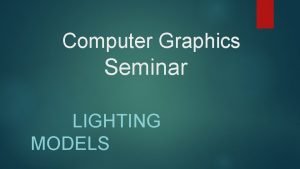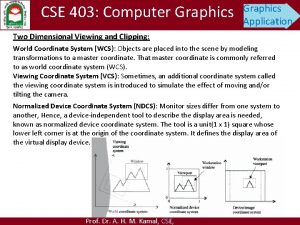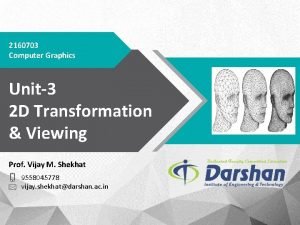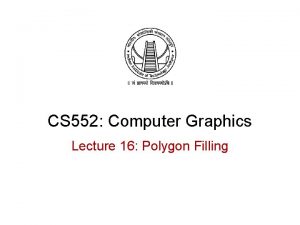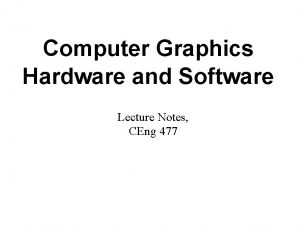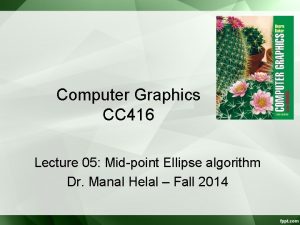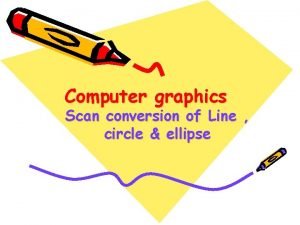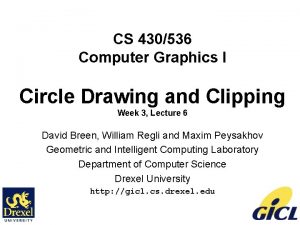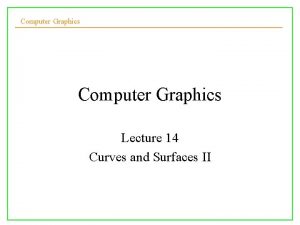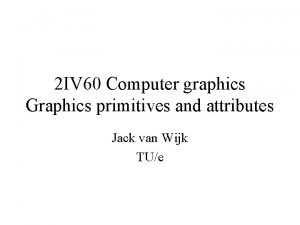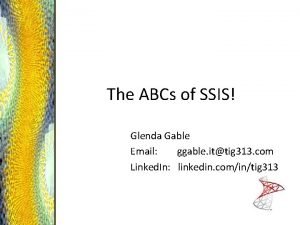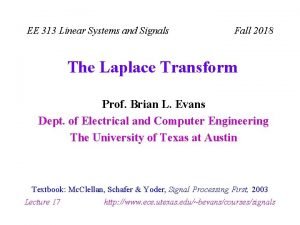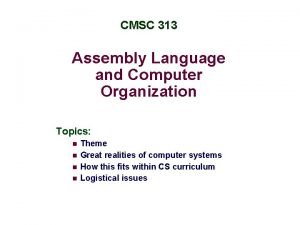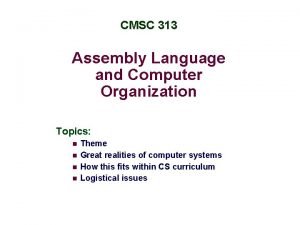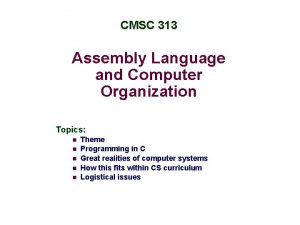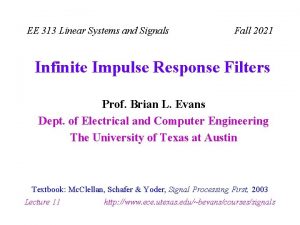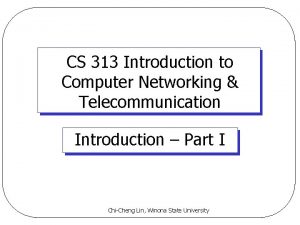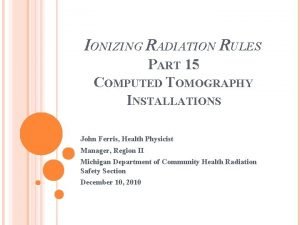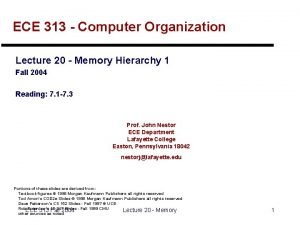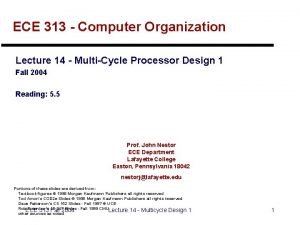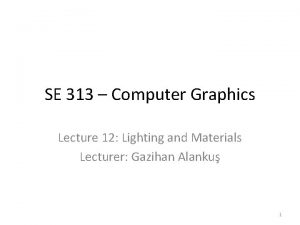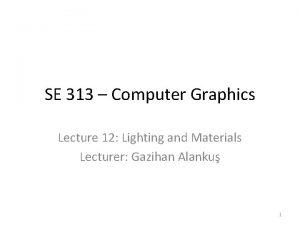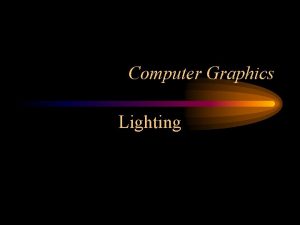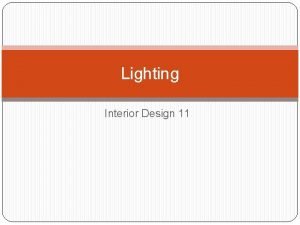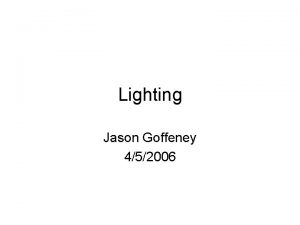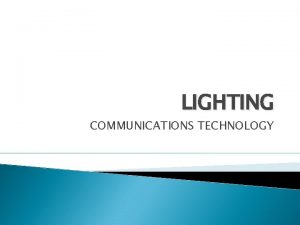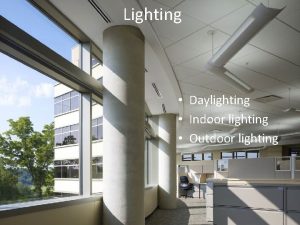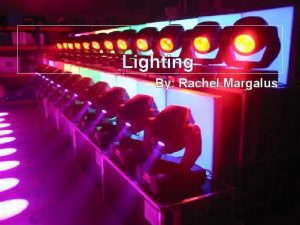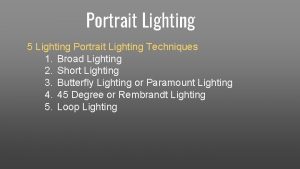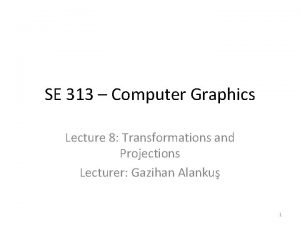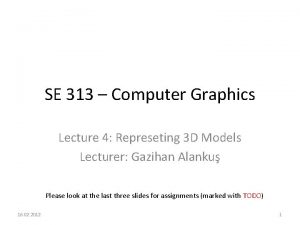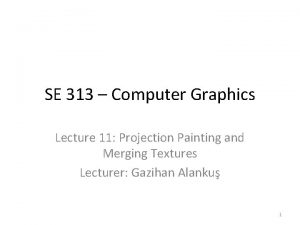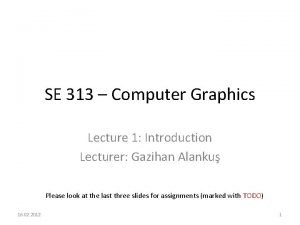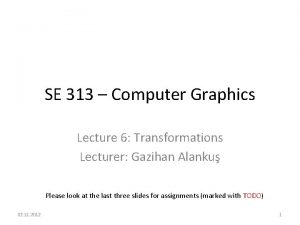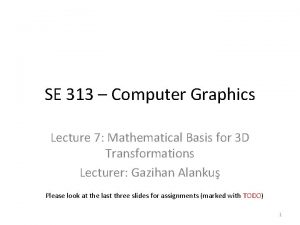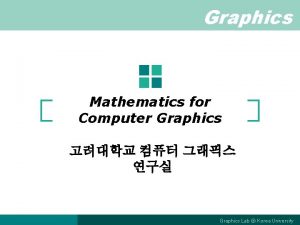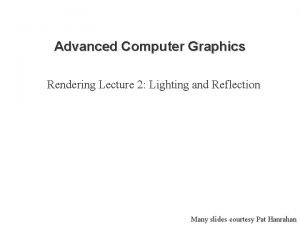SE 313 Computer Graphics Lecture 13 Lighting and









































- Slides: 41

SE 313 – Computer Graphics Lecture 13: Lighting and Materials Practice Lecturer: Gazihan Alankuş 1

Today • Lights and materials • Normal mapping 2

Lights • We learned that the color of the light and the material are used to determine rendering colors 3

Lights • Create a new default Blender scene • The cube should have a material. If not, add a material to it. 4

Lights • Render the scene. • This is what you should see. • Press Esc to go back 5

Lights • Select the lamp • Go to the Object Data tab • Change the color of the lamp to bright red 6

Lights • Render it. Even though the object is not red, it will appear red 7

Lights • Now let’s change the material to blue • Select the cube and go to the material tab • Change the diffuse color to bright blue 8

Lights • Render it • Did you expect purple? Why did this happen? 9

Light: Diffuse and Specular • Now create a new scene, delete the cube and add a UVSphere • Add a material to it • Let’s see the difference between diffuse and specular – Change the diffuse color to green – Change the specular color to red 10

Light: Diffuse and Specular • Render the scene and notice the hint of red near where the light shines • Change specular back to white and render • Notice the difference 11

Light: Ambient • To enable ambient light in the scene, we need to add it to the environment • Go to the world tab • Enable Environment Lighting • Energy: 1 means it’s on • Render the sphere and see that it does not have dark sides anymore 12

Light: Ambient • We can reduce the ambient light’s energy, or reduce how much the material reflects it • Select the sphere and go to the material tab • Under Shading, reduce Ambient to 0 • When you render now, the sphere will ignore the environment light and will have dark sides as before 13

Light: Ambient • Increase it a bit and see how it affects rendering. 14

Light: Emission • We can also simulate objects emitting light • In the same pane, increase Emit to 2 • Now the sphere is more uniformly lit as if it is giving out light 15

Today • Lights and materials • Normal mapping 16

Normal Mapping • We are going to map the normal vectors of one object to another • This will be stored as a texture. The red, green and blue components of the texture will actually represent x, y and z components of the normal vector • We will see how we can render this in Blender • We will see how to make this work in Unity 17

Normal Mapping • Start with a new project • Create a cube and a Icosphere. Scale up the Icosphere by about 1. 3. 18

Normal Mapping: Preparing the Texture • We are going to map the normals of the sphere to the cube. This will be stored in a texture in the cube. For this, we need to prepare our cube for texture mapping. • First split the main view and bring the UV/Image Editor on the left (Right click) 19

Normal Mapping: Preparing the Texture • Select the cube in the 3 D view, go to edit mode, while all faces are selected, unwrap the model using smart uv project. 20

Normal Mapping: Preparing the Texture • Create a blank image and name it normal texture 21

Normal Mapping • The sphere has normal vectors that are a natural result of its shape. • We are going to artificially put (bake) those normal vectors on the cube so that they can be used while rendering to make the cube look a bit like the sphere. – The texture on the cube will hold these normal vectors. 22

Normal Mapping: Baking the Normals • Go to object mode • It is really important that you do this selection exactly in the order it is explained below – Select the sphere first and then shift+select the cube – Think of it as of “from sphere to cube” • The cube should have a yellow outline and the sphere should have an orange outline 23

Normal Mapping: Baking the Normals • Without breaking this selection, go to the render pane • Scroll down to Bake • Select Normals as the bake mode • Check Selected to Active • Click on Bake to start baking 24

Normal Mapping: Baking the Normals • In the UV/Image editor you should see something like this • This is the encoding of x, y, z values of normal vectors into red, green, blue components of the texture. • If you don’t see this, check the thumbnail • If the thumbnail is not black and looks like this, then this is a Blender bug. Save the blend file and the texture, and then reload the image to fix this. 25

Normal Mapping: Using the Normal Texture • Now turn on the texture mode in the 3 D view and move away the sphere. This is what your cube should look like 26

Normal Mapping: Using the Normal Texture • Select the cube and add a material and a texture to it 27

Normal Mapping: Using the Normal Texture • Now let’s prepare the texture. Set its type to Image or Movie • Select the image from the combo • Check Normal Map under Image Sampling • Under Mapping, set Coordinate to UV • Under Influence, uncheck Color and check Normal 28

Normal Mapping: Viewing the Normal Mapping • Now we changed this texture to be used as a normal map. We can see this in the 3 D view by changing some settings. • Make sure the Properties pane is open in the 3 D view • Scroll down to Display • For Shading, select GLSL • Now your cube looks different 29

Normal Mapping: Viewing the Normal Mapping • The cube is rendered differently – Instead of its geometrically calculated normals, its using normals mapped using the texture – Turn the cube to see that it really is trying to act like a sphere 30

Normal Mapping: Final Preparations • • • Reset the rotation of the cube to 0 Delete the sphere Create a new folder Save the blender scene in this folder Save the image in the same folder 31

Normal Mapping: Using it in Unity • Run Unity and create a new project in your hard drive • In My Computer, find the folder that you put the files, and drag it into the Project pane of Unity 32

Normal Mapping: Using it in Unity • When you click on the model you should see its preview like this • Note that Unity didn’t realize that our texture was a normal map and it’s using it as a regular texture. We will fix this 33

Normal Mapping: Using it in Unity • Drag the model into the scene • In the inspector, you will see the material on the bottom. • The material is using our texture as a regular texture. • We need another kind of material that accepts normal maps 34

Normal Mapping: Using it in Unity • Change the Shader to Bumped Diffuse. • Now we have two texture slots, one for the regular texture and one for the normal map. 35

Normal Mapping: Using it in Unity • We need to put our texture into the normal map rather than the regular texture • Click on Select in the regular texture • Select none • Click on Select in the normal map texture • Select the correct texture 36

Normal Mapping: Using it in Unity • Click on Fix Now below to get Unity to really use this texture as a normal map • Now our cube looks more like how it was in Blender • Add a directional light to see it better 37

Normal Mapping: Using it in Unity • Turn it to see that it really is reflecting light like a sphere 38

Normal Mapping: Using it in Unity • To see this in the game view, you can drag and dock it separately • If you don’t see it, you need to select Main Camera in Hierarchy pane and select Game. Object->Align with View in the menu 39

Normal Mapping: Using it in Unity • Select the Directional Light • Rotate it • See how the cube reflects this light Even though it is flat! 40

Lab • Now, map the normal vectors of a cube onto a sphere – Demonstrate it both in Blender and in Unity 41
 Lighting models in computer graphics
Lighting models in computer graphics Graphics monitors and workstations and input devices
Graphics monitors and workstations and input devices Dot matrix display ppt
Dot matrix display ppt 01:640:244 lecture notes - lecture 15: plat, idah, farad
01:640:244 lecture notes - lecture 15: plat, idah, farad Two dimensional viewing
Two dimensional viewing Line drawing algorithm
Line drawing algorithm Bresenham line drawing algorithm example ppt
Bresenham line drawing algorithm example ppt Normalized device coordinate
Normalized device coordinate Shear transformation in computer graphics
Shear transformation in computer graphics Mathematical foundations of computer graphics and vision
Mathematical foundations of computer graphics and vision Points and lines in computer graphics ppt
Points and lines in computer graphics ppt Flood fill algorithm in computer graphics
Flood fill algorithm in computer graphics Hardware and software of computer graphics
Hardware and software of computer graphics Midpoint ellipse drawing algorithm solved example
Midpoint ellipse drawing algorithm solved example Scan conversion of ellipse
Scan conversion of ellipse Define pixmap in computer graphics
Define pixmap in computer graphics Raster scan display advantages and disadvantages
Raster scan display advantages and disadvantages Circle in computer graphics
Circle in computer graphics Computer graphics
Computer graphics Aliasing and antialiasing in computer graphics
Aliasing and antialiasing in computer graphics Filled area primitives in computer graphics
Filled area primitives in computer graphics 100/313
100/313 Ggable
Ggable Ee 313
Ee 313 Cmsc 313
Cmsc 313 Cmsc 313
Cmsc 313 Umbc cmsc 313
Umbc cmsc 313 Csce 313 github
Csce 313 github Ics 313
Ics 313 Corey snyder uiuc
Corey snyder uiuc Ece 313
Ece 313 Ee 313
Ee 313 Ee 313
Ee 313 313 ad
313 ad Csce 313 tanzir
Csce 313 tanzir Distributed system in computer network
Distributed system in computer network Pallini neri
Pallini neri 313 3255719
313 3255719 Bradi 313
Bradi 313 Ece 313
Ece 313 Ece 313
Ece 313 Ece 313
Ece 313
